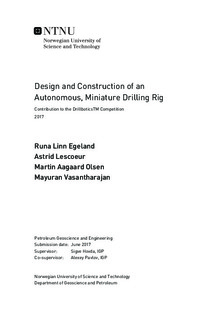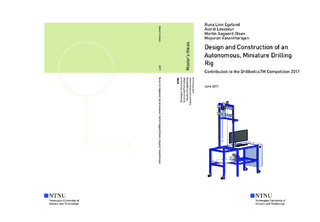| dc.description.abstract | The Society of Petroleum Engineers' (SPE) sub-committee DSATS (Drilling System Automation Technical Section) has, the last two years, organized a student competition in an effort to accelerate the uptake of automation in the drilling industry. The competition is called DrillboticsTM and this is a report of the Norwegian University of Science and Technology's (NTNU) contribution.
The main objective of the competition was to design a fully automated drilling rig that could autonomously drill a vertical well as quickly as possible while maintaining rig and drill string integrity. The winning team was selected based on a set of criteria such as performance, quality of wellbore and data handling. The purpose of this report is to present the team's solution to the problem, describe the rig's main design features and present the main results from the test day. It will also seek to highlight issues related to drilling automation.
The proposed rig design was developed based on new ideas and innovative solutions, as well as current industry practices and guidelines provided by DSATS. Through research and analysis, an evaluation of the most likely drilling related problems and dysfunctions was made and this provided the basis for dimensioning the drilling machine and for designing the control system.
One of the main issues addressed was ensuring that sufficient weight on bit (WOB) could be applied without causing pipe failure. A nozzle was added in the pipe to increase the pipe's internal pressure and thereby also the geometrical stiffness of the pipe. Unfortunately, due to delays and insufficient testing, the internal pressure was not increased as much as originally planned during the on-site test. However, another design feature was implemented to reduce the risk of failure which consisted of adding a roller bearing on the drill deck to increase the buckling limit of the pipe.
Another challenge was to mitigate vibrations in the drill string. This was achieved by adding points of stabilization at the level of the drill deck and at the surface of the rock. This successfully damped the amplitude of the vibrations and stabilized the string while drilling. Through testing, resonance frequencies were detected which made it possible to plan the operating window of the rig above or below the resonance frequencies.
Another important design feature was how the machine optimized the control parameters to increase the speed of drilling. Both the rotational speed of the string and the weight applied to the drill string could be monitored and adjusted while drilling. The optimization function aimed to keep a constant drill string torque set point by adjusting the WOB. This method enabled relatively smooth transitions between different rock formations and reactions to dysfunctions related to stuck pipe and torsional vibrations.
The performance of the rig design and control algorithms was observed and measured by DSATS members during the on-site test at the university 8th June 2017. The drilling rig was able to autonomously drill a vertical well through the rock sample provided by DSATS. The machine continuously sought to optimize the operation by adjusting the control variables and reacted to problems that occurred during the operation. | |

